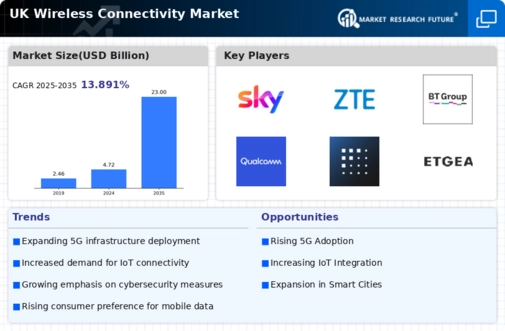Emergence of Smart Cities
The concept of smart cities is gaining traction in the UK, significantly impacting the wireless connectivity market. As urban areas evolve to incorporate smart technologies, the demand for reliable and high-speed wireless networks is increasing. Smart city initiatives often rely on IoT devices, which require robust connectivity to function effectively. Reports suggest that investments in smart city projects could reach £50 billion by 2030, creating a substantial market for wireless connectivity solutions. This trend indicates a shift towards more integrated urban environments, where efficient wireless connectivity is essential for enhancing the quality of life and driving economic growth.
Rising Mobile Data Consumption
The wireless connectivity market in the UK is experiencing a notable surge in mobile data consumption. With the proliferation of smartphones and mobile applications, users are increasingly reliant on high-speed internet access. Recent statistics indicate that mobile data traffic in the UK is projected to grow by approximately 50% annually, driven by the demand for streaming services, social media, and online gaming. This trend necessitates robust wireless infrastructure to accommodate the escalating data needs, thereby propelling investments in network enhancements. As consumers seek seamless connectivity, service providers are compelled to innovate and expand their offerings, which in turn stimulates growth within the wireless connectivity market.
Government Initiatives and Funding
Government initiatives aimed at improving digital infrastructure are significantly influencing the wireless connectivity market in the UK. The UK government has committed substantial funding to enhance broadband access, particularly in rural areas. Recent reports indicate that the government plans to invest £5 billion in expanding gigabit-capable broadband, which is expected to facilitate better wireless connectivity. Such initiatives are crucial for bridging the digital divide and ensuring equitable access to high-speed internet. As these projects progress, they are likely to stimulate growth in the wireless connectivity market, fostering innovation and attracting new players to the industry.
Advancements in Wireless Technologies
Technological advancements are playing a pivotal role in shaping the wireless connectivity market in the UK. Innovations such as Wi-Fi 6 and the ongoing development of 5G technology are enhancing network performance and user experience. Wi-Fi 6, for instance, offers improved speed and capacity, allowing more devices to connect simultaneously without compromising performance. The adoption of these technologies is expected to increase, with estimates suggesting that by 2026, over 80% of households in the UK will have access to high-speed wireless networks. This shift not only enhances consumer satisfaction but also drives competition among service providers, further invigorating the wireless connectivity market.
Increased Focus on Remote Work Solutions
The shift towards remote work has created a heightened demand for reliable wireless connectivity solutions in the UK. As businesses adapt to flexible working arrangements, the need for robust and secure wireless networks has become paramount. Companies are investing in advanced connectivity solutions to support remote teams, which is likely to drive growth in the wireless connectivity market. Recent surveys indicate that over 70% of UK businesses plan to enhance their wireless infrastructure to accommodate remote work. This trend not only reflects changing work dynamics but also underscores the importance of seamless connectivity in maintaining productivity and collaboration.



















Leave a Comment